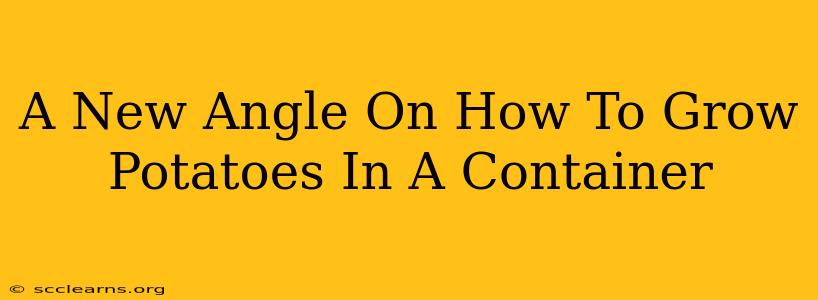Forget sprawling potato patches – container-grown potatoes are the future! This method offers incredible flexibility, making spud cultivation accessible to apartment dwellers, balcony gardeners, and anyone with limited space. But traditional advice often falls short. This guide offers a fresh perspective on how to maximize your yield and enjoy a bountiful harvest, even in a container.
Beyond the Basics: Rethinking Container Potato Growing
Most guides tell you to plant seed potatoes in a large container and wait. While that works, it's not optimized for maximum yield. We'll explore innovative techniques to boost your potato harvest significantly.
1. The "Tower of Power" Method: Vertical Gardening for Potatoes
Instead of a single, wide container, consider a vertical system. Think tiered planters or even repurposed buckets stacked vertically. This maximizes space and allows for better airflow, reducing the risk of fungal diseases common in dense potato plants.
Key Benefits:
- Increased yield: You can fit significantly more potato plants in the same footprint.
- Improved air circulation: Less chance of fungal growth.
- Easier harvesting: Access potatoes from different levels.
Tip: Use breathable fabric pots within the tower to promote healthy root growth.
2. The "Potato Grow Bag" Strategy: Optimized for Growth
Grow bags offer excellent drainage and aeration, crucial for potato plants that dislike soggy conditions. Choose a large grow bag (at least 10 gallons) and ensure it has plenty of drainage holes.
Key Benefits:
- Optimal drainage: Prevents root rot and other water-related issues.
- Lightweight and portable: Easily move your potato plants as needed.
- Good air circulation: Similar benefits to the tower method.
3. Light, Soil, and Water: The Holy Trinity of Container Potato Growing
While space-saving is key, don't compromise on the essentials.
- Sunlight: Potatoes crave at least 6-8 hours of direct sunlight daily. South-facing locations are ideal.
- Soil: Use a well-draining potting mix, not garden soil, to prevent compaction. Consider adding compost for nutrients.
- Watering: Consistent moisture is important, but avoid overwatering, which can lead to rot. Water deeply but less frequently, allowing the soil to dry slightly between waterings.
Choosing the Right Potato Variety
Not all potatoes are created equal for container gardening. Look for compact or early-season varieties that mature quickly and don't require excessive space. Check your local garden center for recommendations tailored to your climate.
Harvest Time! Knowing When Your Potatoes Are Ready
The time to harvest depends on the variety you selected, but typically it's around 70-100 days after planting. Look for signs of the plant dying back. Gently feel around the base of the plant; you'll likely feel some potatoes forming.
Beyond the Harvest: Preparing for Next Year
Save some of your best potatoes for planting next season. Store them in a cool, dark, and dry place. This ensures you have your own supply of seed potatoes for a continuous cycle of homegrown goodness.
Conclusion: Container Potatoes – A Rewarding Experience
Growing potatoes in containers is a rewarding venture, even for beginners. By applying these new strategies and focusing on the essentials of sunlight, soil, and water, you’ll significantly increase your yield and enjoy a delicious harvest. So, ditch the traditional methods, embrace innovation, and get ready for a bumper crop of homegrown potatoes!

